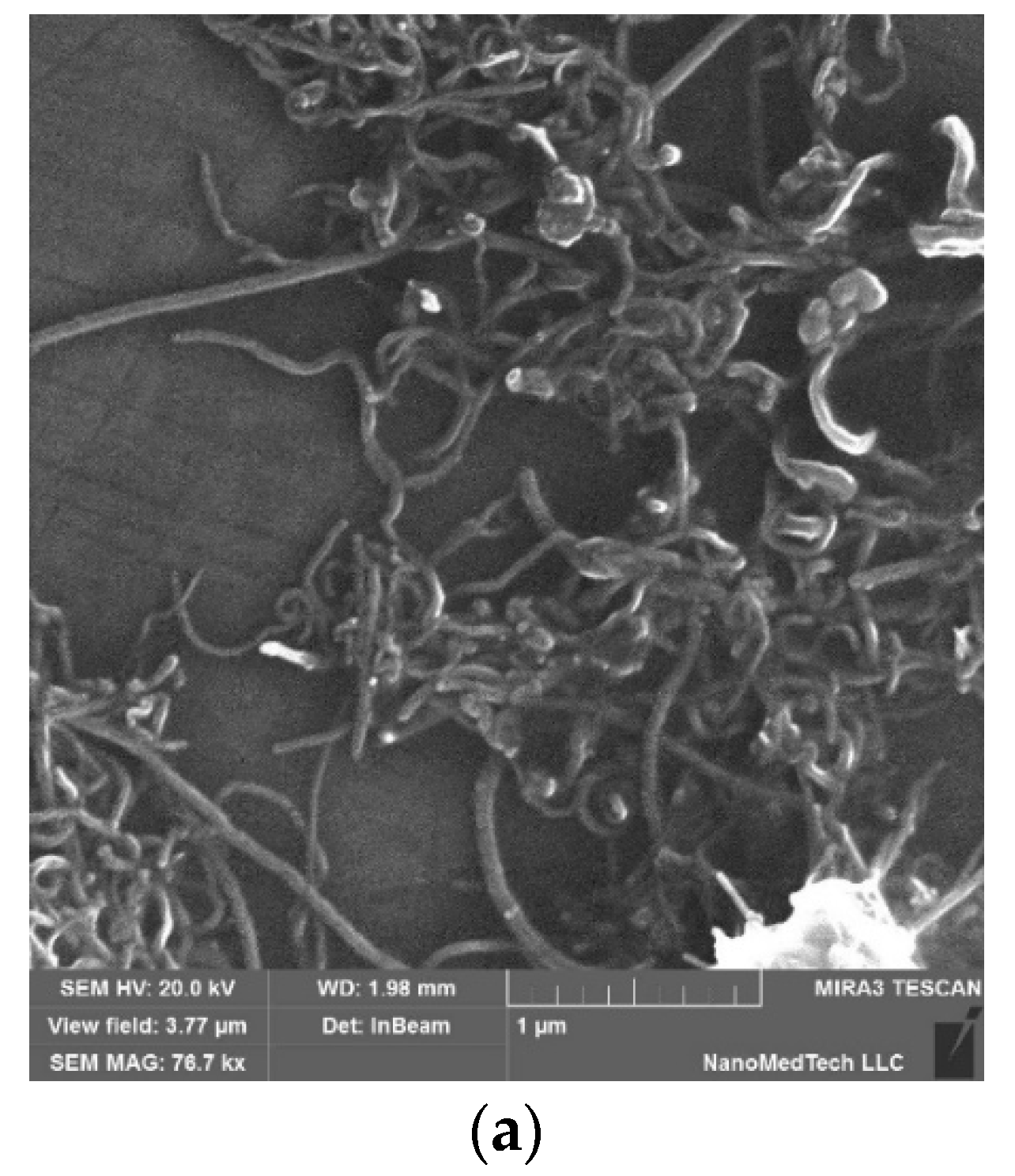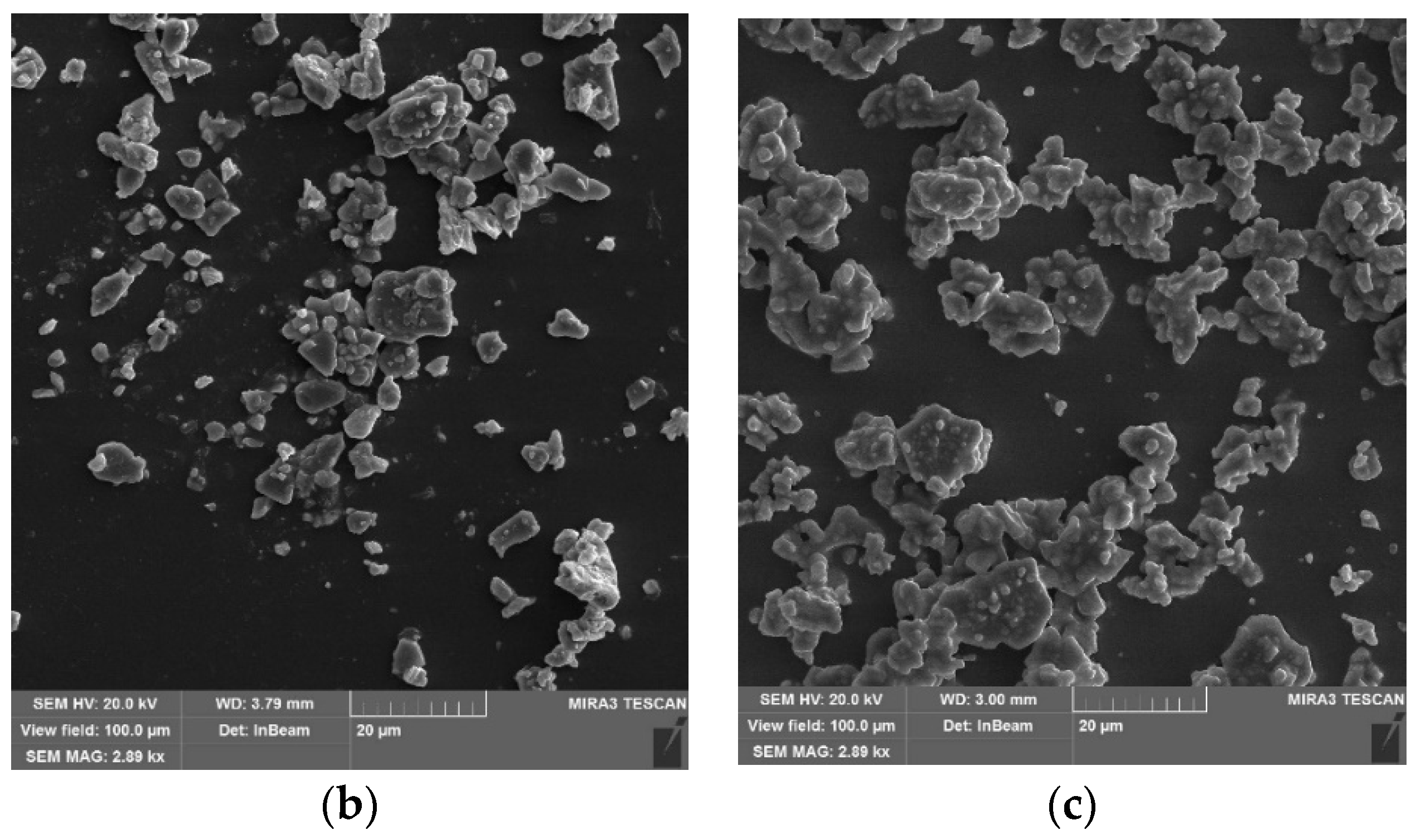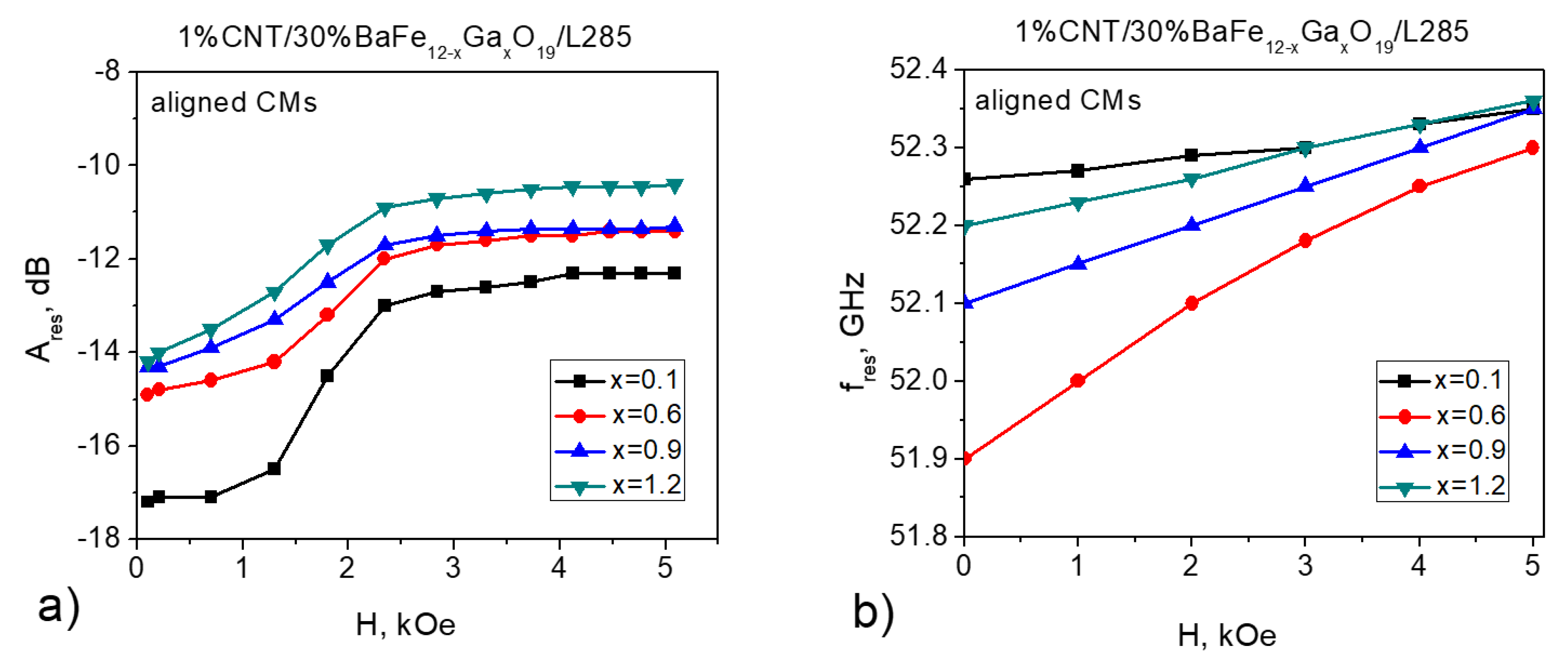Electromagnetic Properties of Carbon Nanotube/BaFe12−xGaxO19/Epoxy Composites with Random and Oriented Filler Distributions
Abstract
:1. Introduction
2. Materials and Methods
3. Results and Discussion
3.1. Amplitude-Frequency Characteristics of NFMR
3.2. Amplitude-Frequency Characteristics of NFMR for 1% CNT/30% BaFe12-xGaxO19/Epoxy Composites at Applied Magnetic Field
4. Conclusions
Author Contributions
Funding
Data Availability Statement
Conflicts of Interest
References
- Choi, I.; Kim, J.G.; Seo, I. Radar absorbing sandwich construction composed of CNT, PMI foam and carbon/epoxy composite. Compos. Struct. 2012, 94, 3002–3008. [Google Scholar] [CrossRef]
- Gupta, K.K.; Abbas, S.M.; Goswami, T.H. Microwave absorption in X and Ku band frequency of cotton fabric coated with Ni–Zn ferrite and carbon formulation in polyurethane matrix. J. Magn. Magn. Mater. 2014, 362, 216–225. [Google Scholar] [CrossRef]
- Saini, P.; Choudhary, V.; Vijayan, N. Improved electromagnetic interference shielding response of poly (aniline)-coated fabrics containing dielectric and magnetic nanoparticles. J. Phys. Chem. C 2012, 116, 13403–13412. [Google Scholar] [CrossRef]
- Rosa, I.M.; Dinescu, A.; Sarasin, F. Effect of short carbon fibers and MWCNTs on microwave absorbing properties of polyester composites containing nickel-coated carbon fibers. Compos. Sci. Technol. 2010, 70, 102–109. [Google Scholar] [CrossRef]
- Liu, L.; Duan, Y.; Ma, L. Microwave absorption properties of a wave-absorbing coating employing carbonyl-iron powder and carbon black. Appl. Surf. Sci. 2010, 257, 842–846. [Google Scholar] [CrossRef]
- Vovchenko, L.L.; Lozitsky, O.V.; Oliynyk, V.V.; Matzui, L.Y.; Milovanov, Y.S. Dielectric and microwave shielding properties of three-phase composites graphite nanoplatelets/carbonyl iron/epoxy resin. Appl. Nanosci. 2020, 10, 4781–4790. [Google Scholar] [CrossRef]
- Pullar, R.C. Hexagonal ferrites: A review of the synthesis, properties and applications of hexaferrite ceramics. Prog. Mater. Sci. 2012, 57, 1191–1334. [Google Scholar] [CrossRef]
- Shakoor, S.; Ashiq, M.N.; Malana, M.A.; Mahmood, A.; Warsi, M.F.; Haq, M.; Karamat, N. Electrical, dielectric and magnetic characterization of Bi-Cr substituted M-type strontium hexaferrite nanomaterials. J. Magn. Magn. Mater. 2014, 362, 110–114. [Google Scholar] [CrossRef]
- Trukhanov, A.V.; Panina, L.V.; Trukhanov, S.V.; Kostishyn, V.G.; Turchenko, V.A.; Vinnik, D.A.; Zubar, T.I.; Yakovenko, E.S.; Macuy, L.Y.; Trukhanova, E.L. Critical influence of different diamagnetic ions on electromagnetic properties of BaFe12O19. Ceram. Int. 2018, 44, 13520–13529. [Google Scholar] [CrossRef]
- Ali, K.S.; Ravikumar, M.M.; Mohammed, J.; Naeim, F.; Mohanavel, V.; Ravichandrang, M. Investigation of Ku band microwave absorption of three-layer BaFe12O19, carbon-fiber@Fe3O4, and graphene@BaFe12O19@Fe3O4 composite. J. Alloys Compd. 2021, 884, 161045. [Google Scholar] [CrossRef]
- Ghasemi, A. The role of multi-walled carbon nanotubes on the magnetic and refection loss characteristics of substituted strontium ferrite nanoparticles. J. Magn. Magn. Mater. 2013, 330, 163–168. [Google Scholar] [CrossRef]
- Nikmanesh, H.; Moradi, M.; Bordbar, G.H.; Alam, R.S. Synthesis of multi-walled carbon nanotube/doped barium hexaferrite nanocomposites: An investigation of structural, magnetic and microwave absorption properties. Ceram. Int. 2016, 42, 14342–14349. [Google Scholar] [CrossRef]
- Ghasemi, A.; Shirsath, S.E.; Liu, X.; Morisako, A. Enhanced reflection loss characteristics of substituted barium ferrite/functionalized multi-walled carbon nanotube nanocomposites. J. Appl. Phys. 2011, 109, 07A507. [Google Scholar] [CrossRef]
- Mathews, S.A.; Babu, D.R. Analysis of the role of M-type hexaferrite-based materials in electromagnetic interference shielding. Curr. Appl. Phys. 2021, 29, 39–53. [Google Scholar] [CrossRef]
- Yasmin, N.; Zahid, M.; Khan, H.M.; Hashim, M.; Islam, M.U.; Yasmin, S.; Altaf, M.; Nazar, B.; Safdar, M.; Mirza, M. Structural and dielectric properties of Gd-Zn substituted Ca0.5Ba0.5Fe12O19 M-type hexa-ferrites synthesized via auto-combustion method. J. Alloys Compd. 2019, 774, 962–968. [Google Scholar] [CrossRef]
- Ghasemi, A.; Hossienpour, A.; Morisako, A.; Saatchi, A.; Salehi, M. Electromagnetic properties and microwave absorbing characteristics of doped barium hexaferrite. J. Magn. Magn. Mater. 2006, 302, 429–435. [Google Scholar] [CrossRef]
- Zhao, B.; Guo, X.; Zhao, W.; Deng, J.; Shao, G.; Fan, B.; Bai, Z.; Zhang, R. Yolk-Shell Ni@SnO2 composites with a designable interspace to improve the electromagnetic wave absorption properties. ACS Appl. Mater. Interf. 2016, 8, 28917–28925. [Google Scholar] [CrossRef]
- Meena, R.S.; Bhattachrya, S.; Chatterjee, R. Complex permittivity, permeability and microwave absorbing studies of (Co2−xMnx) U-type hexaferrite for X-band (8.2-12.4 GHz) frequencies. Mater. Sci. Eng. B 2010, 171, 133–138. [Google Scholar] [CrossRef]
- Zezyulina, P.A.; Petrov, D.A.; Rozanov, K.N.; Vinnik, D.A.; Maklakov, S.S.; Zhivulin, V.E.; Starikov, A.Y.; Sherstyuk, D.P.; Shannigrahi, S. Study of the static and microwave magnetic properties of nanostructured BaFe12−xTixO19. Coatings 2020, 10, 789. [Google Scholar] [CrossRef]
- Handoko, E.; Budi, S.; Sugihartono, I.; Marpaung, M.A.; Jalil, Z.; Taufiq, A.; Alaydrus, M. Microwave absorption performance of barium hexaferrite multi-nanolayers. Mater. Express 2020, 10, 1328–1336. [Google Scholar] [CrossRef]
- Dotsenko, O.A.; Frolov, K.O. Microwave composite absorbers based on barium hexaferrite/carbon nanotubes for 0.01–18 GHz applications. In Key Engineering Materials; Trans Tech Publications, Ltd.: Bäch, Switzerland, 2016; Volume 685, pp. 553–557. [Google Scholar] [CrossRef]
- Li, J.; Xu, T.; Liu, L.; Hong, Y.; Song, Z.; Bai, H.; Zhou, Z. Microstructure, magnetic and low-frequency microwave absorption properties of doped Co-Ti hexagonal barium ferrite nanoparticles. Ceram. Int. 2021, 47, 19247–19253. [Google Scholar] [CrossRef]
- Rosdi, N.; Azis, R.S.; Ismail, I.; Mokhtar, N.; Zulkimi, M.M.M.; Mustaffa, M.S. Structural, microstructural, magnetic and electromagnetic absorption properties of spiraled multiwalled carbon nanotubes/barium hexaferrite (MWCNTs/BaFe12O19) hybrid. Sci. Rep. 2021, 11, 15982. [Google Scholar] [CrossRef]
- Yakovenko, O.S.; Matzui, L.Y.; Vovchenko, L.L.; Lozitsky, O.V.; Prokopov, O.I.; Lazarenko, O.A.; Zhuravkov, A.V.; Oliynyk, V.V.; Launets, V.L.; Trukhanov, S.V.; et al. Electrophysical properties of epoxy-based composites with graphite nanoplatelets and magnetically aligned magnetite. Mol. Cryst. Liq. Cryst. 2018, 661, 68–80. [Google Scholar] [CrossRef]
- Trukhanov, S.V.; Trukhanov, A.V.; Kostishyn, V.G.; Panina, L.V.; Trukhanov, A.V.; Turchenko, V.A.; Tishkevich, D.I.; Trukhanova, E.L.; Yakovenko, O.S.; Matzui, L.Y.; et al. Effect of gallium doping on electromagnetic properties of barium hexaferrite. J. Phys. Chem. Sol. 2017, 111, 142–152. [Google Scholar] [CrossRef]
- Yakovenko, O.S.; Matzui, L.Y.; Vovchenko, L.L.; Oliynyk, V.V.; Trukhanov, A.V.; Trukhanov, S.V.; Borovoy, M.O.; Tesel’ko, P.O.; Launets, V.L.; Syvolozhskyi, O.A.; et al. Effect of magnetic fillers and their orientation on the electrodynamic properties of BaFe12-xGaxO19 (x = 0.1–1.2)—Epoxy composites with carbon nanotubes within GHz range. Appl. Nanosci. 2020, 10, 4747–4752. [Google Scholar] [CrossRef]
- Matzui, L.Y.; Yakovenko, O.S.; Vovchenko, L.L.; Oliynyk, V.V.; Zagorodnii, V.V.; Launets, V.L. Chapter 14: Conductive and shielding properties of MWCNTs/Polymer nanocomposites with aligned filler distribution. In NATO Science for Peace and Security Series B: Physics and Biophysics; Maffucci, A., Maksimenko, S.A., Eds.; Springer: Dordrecht, The Netherlands, 2016; pp. 251–271. [Google Scholar] [CrossRef]
- Yakovenko, O.; Matzui, L.; Danylova, G.; Zadorozhnii, V.; Vovchenko, L.; Perets, Y.; Lazarenko, O. Electrical properties of composite materials with electric field-assisted alignment of nanocarbon fillers. Nanoscale Res. Lett. 2017, 12, 471. [Google Scholar] [CrossRef]
- Joo, J.; Lee, C.Y. High frequency electromagnetic interference shielding response of mixtures and multilayer films based on conducting polymers. J. Appl. Phys. 2000, 8, 513–518. [Google Scholar] [CrossRef]
- Liu, Z.; Bai, G.; Huang, Y.; Ma, Y.; Du, F.; Li, F.; Guo, T.; Chen, Y. Reflection and absorption contributions to the electromagnetic interference shielding of single-walled carbon nanotube/polyurethane composites. Carbon 2007, 45, 821–827. [Google Scholar] [CrossRef]
- Matzui, L.Y.; Yakovenko, O.S.; Vovchenko, L.L.; Lozitsky, O.V.; Oliynyk, V.V.; Zagorodnii, V.V. Chapter 6: Polymer nanocomposites with hybrid fillers as materials with controllable electrodynamic characteristics for microwave devices. In Fundamental and Applied Nano-Electromagnetics II. NATO Science for Peace and Security Series B: Physics and Biophysics; Maffucci, A., Maksimenko, S., Eds.; Springer: Dordrecht, The Netherlands, 2019; pp. 91–112. [Google Scholar]
- Sun, L.L.; Li, B.; Mitchell, G.; Zhong, W.H. Structure-induced high dielectric constant and low loss of CNF/PVDF composites with heterogeneous CNF distribution. Nanotechnology 2010, 21, 305702. [Google Scholar] [CrossRef]
- Su, X.; Ning, J.; Jia, Y.; Liu, Y. Flower-like MoS2 Nanospheres: A promising material with good microwave absorption property in the frequency range of 8.2–12.4 GHz. NANO Brief Rep. Rev. 2018, 13, 1850084. [Google Scholar] [CrossRef]
- Matzui, L.Y.; Trukhanov, A.V.; Yakovenko, O.S.; Vovchenko, L.L.; Zagorodnii, V.V.; Oliynyk, V.V.; Borovoy, M.O.; Trukhanova, E.L.; Astapovich, K.A.; Karpinsky, D.V.; et al. Functional magnetic composites based on hexaferrites: Correlation of the composition, magnetic and high-frequency properties. Nanomaterials 2019, 9, 1720. [Google Scholar] [CrossRef] [PubMed] [Green Version]
- Song, Y.Y.; Kalaricka, S.; Patton, C.E. Optimized pulsed laser deposited barium ferrite thin films with narrow ferromagnetic resonance linewidths. J. Appl. Phys. 2003, 94, 5103. [Google Scholar] [CrossRef]
- Chen, D.; Chen, Z.; Wang, G.; Chen, Y.; Li, Y. Magnetic properties and millimeter wave loss of highly oriented scandium substituted barium hexaferrite thin films for millimeter wave applications. J. Mater. Sci. Mater. Electron. 2017, 28, 6737–6740. [Google Scholar] [CrossRef]
- Yakovenko, O.; Matzui, L.; Vovchenko, L.; Trukhanov, A.; Kazakevich, I.; Trukhanov, S.; Prylutskyy, Y.; Ritter, U. Magnetic anisotropy of the graphite nanoplatelet–epoxy and MWCNT–epoxy composites with aligned barium ferrite filler. J. Mat. Sci. 2017, 52, 5345–5358. [Google Scholar] [CrossRef]
- Issa, B.; Obaidat, I.M.; Albiss, B.A.; Haik, Y. Magnetic nanoparticles: Surface effects and properties related to biomedicine applications. Int. J. Mol. Sci. 2013, 14, 21266–21305. [Google Scholar] [CrossRef] [Green Version]
- El-Sayed, A.H.; Hemeda, O.M.; Tawfik, A.; Hamad, M.A. Remarkable magnetic enhancement of type-M hexaferrite of barium in polystyrenepolymer. AIP Adv. 2015, 5, 107131. [Google Scholar] [CrossRef]
- Trukhanov, V.; Trukhanov, A.V.; Kostishin, V.G.; Panina, L.V.; Kazakevich, I.S.; Turchenko, V.A.; Oleinik, V.V.; Yakovenko, E.S.; Matsui, L.Y. Magnetic and absorbing properties of M-type substituted hexaferrites BaFe12–xGaxO19 (0.1 < x < 1.2). J. Exp. Theor. Phys. 2016, 123, 461–469. [Google Scholar]
- Ustinov, A.B.; Tatarenko, A.S.; Srinivasan, G.; Balbashov, A.M. Al substituted Ba-hexaferrite single-crystal films for millimeter-wave devices. J. Appl. Phys. 2009, 105, 023908. [Google Scholar] [CrossRef]
- Jeon, J.; Park, J.E.; Park, S.J.; Won, S.; Zhao, H.; Kim, S.; Shim, B.S.; Urbas, A.; Hart, A.J.; Ku, Z.; et al. Shape-Programmed Fabrication and Actuation of Magnetically Active Micropost Arrays. ACS Appl. Mater. Interfaces 2020, 12, 17113–17120. [Google Scholar] [CrossRef]
- Park, J.E.; Jeon, J.; Park, S.J.; Won, S.; Ku, Z.; Wie, J.J. Enhancement of Magneto-Mechanical Actuation of Micropillar Arrays by Anisotropic Stress Distribution. Small 2020, 16, 2003179. [Google Scholar] [CrossRef]






| Composite Material | σ, S/m | Ref. | ||||
|---|---|---|---|---|---|---|
| f = 40 GHz, d = 2.6 mm | ||||||
| Epoxy resin L285 | 1.0 × 10−11 | −1 | 2.9 | 0.008 | 1 | [28] |
| 30%BaFe12O19/L285 | 1.0 × 10−10 | −1 | 4.0 | 0.21 | 1.45 | [31] |
| 1%CNT/L285 | 2.0 × 10−8 | −4 | 3.8 | 0.57 | 1 | [27,28] |
| 1%CNT/30%BaM/L285 | 5.0 × 10−8 | −10 | - | - | This work | |
| Composite | Filler Distribution | Hc, kA/m | Ref. | ||
|---|---|---|---|---|---|
| Pressed polycrystalline BaFe11.9Ga0.1O19 | - | 175.07 | 56 | ~1591.549 | [40] |
| Pressed polycrystalline BaFe11.4Ga0.6O19 | - | 59.683 | 46 | ~1591.549 | [40] |
| Pressed polycrystalline BaFe10.8Ga1.2O19 | - | 39.788 | 30 | ~1591.549 | [40] |
| 30 wt.% BaFe11.9Ga0.1O19/epoxy | random aligned | 47.746 45.359 | 18.84 28.37 | 2641.972 1901.901 | [39] |
| 30 wt.% BaFe11.4Ga0.6O19/epoxy | random aligned | 85.943 81.964 | 17.53 20.32 | 2570.357 2347.535 | [39] |
| 30 wt.% BaFe10.8Ga1.2O19/epoxy | random aligned | 132.098 126.528 | 14.94 14.72 | 2514.648 2299.788 | [39] |
Publisher’s Note: MDPI stays neutral with regard to jurisdictional claims in published maps and institutional affiliations. |
© 2021 by the authors. Licensee MDPI, Basel, Switzerland. This article is an open access article distributed under the terms and conditions of the Creative Commons Attribution (CC BY) license (https://creativecommons.org/licenses/by/4.0/).
Share and Cite
Yakovenko, O.S.; Matzui, L.Y.; Vovchenko, L.L.; Oliynyk, V.V.; Zagorodnii, V.V.; Trukhanov, S.V.; Trukhanov, A.V. Electromagnetic Properties of Carbon Nanotube/BaFe12−xGaxO19/Epoxy Composites with Random and Oriented Filler Distributions. Nanomaterials 2021, 11, 2873. https://doi.org/10.3390/nano11112873
Yakovenko OS, Matzui LY, Vovchenko LL, Oliynyk VV, Zagorodnii VV, Trukhanov SV, Trukhanov AV. Electromagnetic Properties of Carbon Nanotube/BaFe12−xGaxO19/Epoxy Composites with Random and Oriented Filler Distributions. Nanomaterials. 2021; 11(11):2873. https://doi.org/10.3390/nano11112873
Chicago/Turabian StyleYakovenko, Olena S., Lyudmila Yu. Matzui, Ludmila L. Vovchenko, Victor V. Oliynyk, Volodymyr V. Zagorodnii, Sergei V. Trukhanov, and Alex V. Trukhanov. 2021. "Electromagnetic Properties of Carbon Nanotube/BaFe12−xGaxO19/Epoxy Composites with Random and Oriented Filler Distributions" Nanomaterials 11, no. 11: 2873. https://doi.org/10.3390/nano11112873
APA StyleYakovenko, O. S., Matzui, L. Y., Vovchenko, L. L., Oliynyk, V. V., Zagorodnii, V. V., Trukhanov, S. V., & Trukhanov, A. V. (2021). Electromagnetic Properties of Carbon Nanotube/BaFe12−xGaxO19/Epoxy Composites with Random and Oriented Filler Distributions. Nanomaterials, 11(11), 2873. https://doi.org/10.3390/nano11112873







